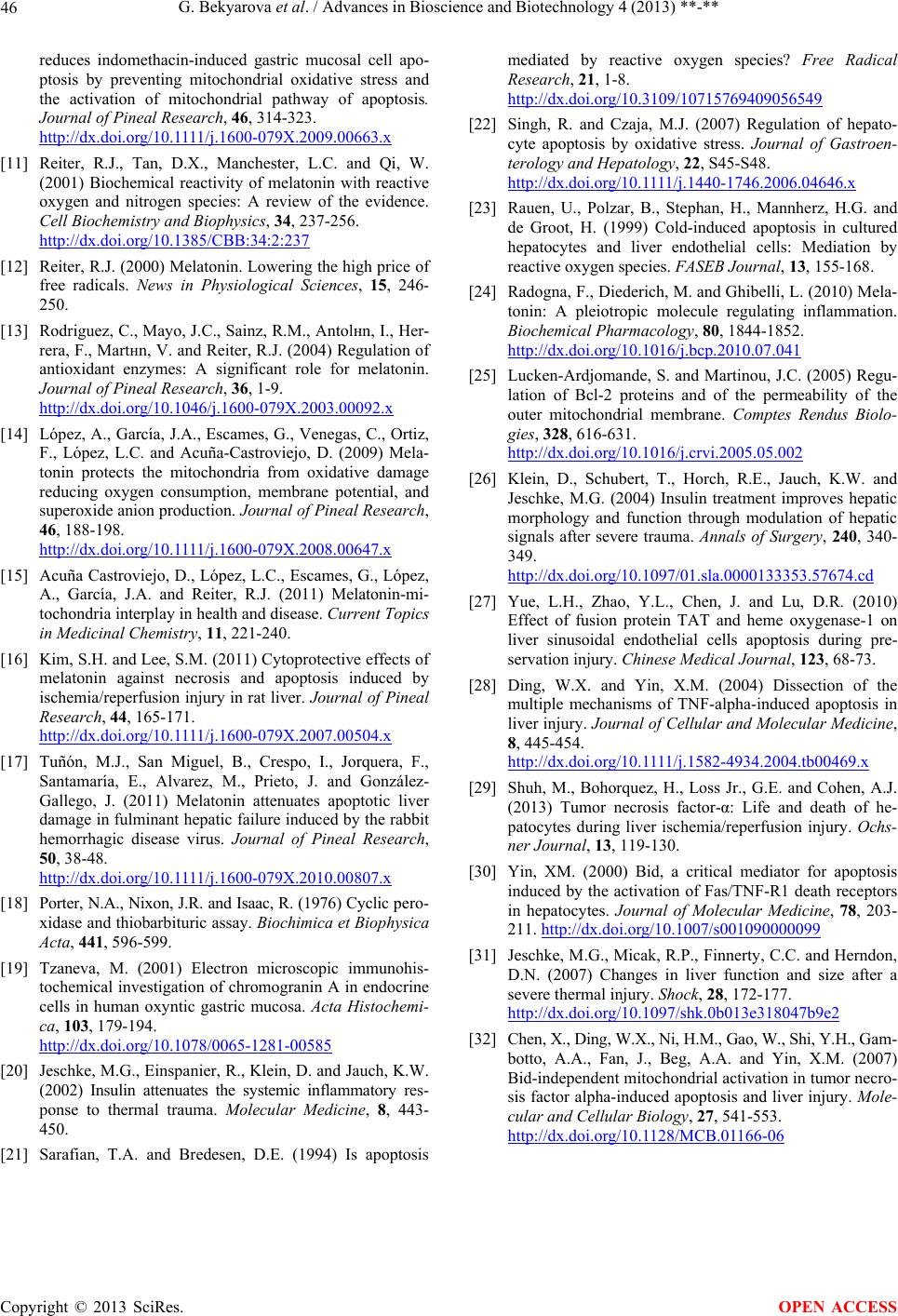
G. Bekyarova et al. / Advances in Bioscience and Biotechnology 4 (2013) **-**
Copyright © 2013 SciRes.
46
OPEN ACCESS
reduces indomethacin-induced gastric mucosal cell apo-
ptosis by preventing mitochondrial oxidative stress and
the activation of mitochondrial pathway of apoptosis.
Journal of Pineal Research, 46, 314-323.
http://dx .do i.org/1 0.1111 /j.1600-079X.2009.00663.x
[11] Reiter, R.J., Tan, D.X., Manchester, L.C. and Qi, W.
(2001) Biochemical reactivity of melatonin with reactive
oxygen and nitrogen species: A review of the evidence.
Cell Biochemistry and Biophysics, 34, 237-256.
http://dx.doi.org/10.1385/CBB:34:2:237
[12] Reiter, R.J. (2000) Melatonin. Lowering the high price of
free radicals. News in Physiological Sciences, 15, 246-
250.
[13] Rodriguez, C., Mayo, J.C., Sainz, R.M., Antolнn, I., Her-
rera, F., Martнn, V. and Reiter, R.J. (2004) Regulation of
antioxidant enzymes: A significant role for melatonin.
Journal of Pineal Research, 36, 1-9.
http://dx.doi.org/10.1046/j.1600-079X.2003.00092.x
[14] López, A., García, J.A., Escames, G., Venegas, C., Ortiz,
F., López, L.C. and Acuña-Castroviejo, D. (2009) Mela-
tonin protects the mitochondria from oxidative damage
reducing oxygen consumption, membrane potential, and
superoxide anion production. Journal of Pineal Research,
46, 188-198.
http://dx .do i.org/1 0.1111 /j.1600-079X.2008.00647.x
[15] Acuña Castroviejo, D., López, L.C., Escames, G., López,
A., García, J.A. and Reiter, R.J. (2011) Melatonin-mi-
tochondria interplay in health and disease. Current Topics
in Medicinal Chemistry, 11, 221-240.
[16] Kim, S.H. and Lee, S.M. (2011) Cytoprotective effects of
melatonin against necrosis and apoptosis induced by
ischemia/reperfusion injury in rat liver. Journal of Pineal
Research, 44, 165-171.
http://dx .do i.org/1 0.1111 /j.1600-079X.2007.00504.x
[17] Tuñón, M.J., San Miguel, B., Crespo, I., Jorquera, F.,
Santamaría, E., Alvarez, M., Prieto, J. and González-
Gallego, J. (2011) Melatonin attenuates apoptotic liver
damage in fulminant hepatic failure induced by the rabbit
hemorrhagic disease virus. Journal of Pineal Research,
50, 38-48.
http://dx .do i.org/1 0.1111 /j.1600-079X.2010.00807.x
[18] Porter, N.A., Nixon, J.R. and Isaac, R. (1976) Cyclic pero-
xidase and thiobarbituric assay. Biochimica et Biophysica
Acta, 441, 596-599.
[19] Tzaneva, M. (2001) Electron microscopic immunohis-
tochemical investigation of chromogranin A in endocrine
cells in human oxyntic gastric mucosa. Acta Histochemi-
ca, 103, 179-194.
http://dx.doi.org/10.1078/0065-1281-00585
[20] Jeschke, M.G., Einspanier, R., Klein, D. and Jauch, K.W.
(2002) Insulin attenuates the systemic inflammatory res-
ponse to thermal trauma. Molecular Medicine, 8, 443-
450.
[21] Sarafian, T.A. and Bredesen, D.E. (1994) Is apoptosis
mediated by reactive oxygen species? Free Radical
Research, 21, 1-8.
http://dx.doi.org/10.3109/10715769409056549
[22] Singh, R. and Czaja, M.J. (2007) Regulation of hepato-
cyte apoptosis by oxidative stress. Journal of Gastroen-
terology and Hepatology, 22, S45-S48.
http://dx .do i.org/1 0.1111 /j.1440-1746.2006.04646.x
[23] Rauen, U., Polzar, B., Stephan, H., Mannherz, H.G. and
de Groot, H. (1999) Cold-induced apoptosis in cultured
hepatocytes and liver endothelial cells: Mediation by
reactive oxygen species. FASEB Journal, 13, 155-168.
[24] Radogna, F., Diederich, M. and Ghibelli, L. (2010) Mela-
tonin: A pleiotropic molecule regulating inflammation.
Biochemical Pharmacology, 80, 1844-1852.
http://dx.doi.org/10.1016/j.bcp.2010.07.041
[25] Lucken-Ardjomande, S. and Martinou, J.C. (2005) Regu-
lation of Bcl-2 proteins and of the permeability of the
outer mitochondrial membrane. Comptes Rendus Biolo-
gies, 328, 616-631.
http://dx.doi.org/10.1016/j.crvi.2005.05.002
[26] Klein, D., Schubert, T., Horch, R.E., Jauch, K.W. and
Jeschke, M.G. (2004) Insulin treatment improves hepatic
morphology and function through modulation of hepatic
signals after severe trauma. Annals of Surgery, 240, 340-
349.
http://dx.doi.org/10.1097/01.sla.0000133353.57674.cd
[27] Yue, L.H., Zhao, Y.L., Chen, J. and Lu, D.R. (2010)
Effect of fusion protein TAT and heme oxygenase-1 on
liver sinusoidal endothelial cells apoptosis during pre-
servation injury. Chinese Medical Journal, 123, 68-73.
[28] Ding, W.X. and Yin, X.M. (2004) Dissection of the
multiple mechanisms of TNF-alpha-induced apoptosis in
liver injury. Journal of Cellular and Molecular Medicine,
8, 445-454.
http://dx .do i.org/1 0.1111 /j.1582-4934.2004.tb00469.x
[29] Shuh, M., Bohorquez, H., Loss Jr., G.E. and Cohen, A.J.
(2013) Tumor necrosis factor-α: Life and death of he-
patocytes during liver ischemia/reperfusion injury. Ochs-
ner Journal, 13, 119-130.
[30] Yin, XM. (2000) Bid, a critical mediator for apoptosis
induced by the activation of Fas/TNF-R1 death receptors
in hepatocytes. Journal of Molecular Medicine, 78, 203-
211. http://dx.doi.org/10.1007/s001090000099
[31] Jeschke, M.G., Micak, R.P., Finnerty, C.C. and Herndon,
D.N. (2007) Changes in liver function and size after a
severe thermal injury. Shock, 28, 172-177.
http://dx.doi.org/10.1097/shk.0b013e318047b9e2
[32] Chen, X., Ding, W.X., Ni, H.M., Gao, W., Shi, Y.H., Gam-
botto, A.A., Fan, J., Beg, A.A. and Yin, X.M. (2007)
Bid-independent mitochondrial activation in tumor necro-
sis factor alpha-induced apoptosis and liver injury. Mole-
cular and Cellular Biology, 27, 541-553.
http://dx.doi.org/10.1128/MCB.01166-06